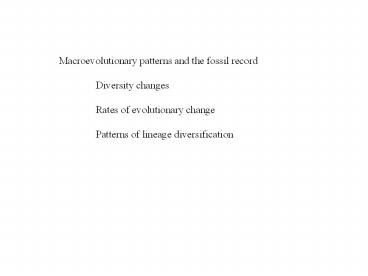Macroevolutionary patterns and the fossil record - PowerPoint PPT Presentation
Title:
Macroevolutionary patterns and the fossil record
Description:
Title: PowerPoint Presentation Author: Diane Wiernasz Last modified by: Blaine Cole Created Date: 11/20/2003 9:38:32 PM Document presentation format – PowerPoint PPT presentation
Number of Views:174
Avg rating:3.0/5.0
Title: Macroevolutionary patterns and the fossil record
1
Macroevolutionary patterns and the fossil
record Diversity changes Rates of
evolutionary change Patterns of lineage
diversification
2
Patterns of diversification in the Phanerozoic
-- rapid rise in the number of taxa
-- extinct lineages are replaced
ecologically by many representatives at
lower taxonomic levels (e.g., an order by
several genera) -- diversification
of ecosystems
3
(No Transcript)
4
(No Transcript)
5
distribution of relative brain size in predators
and prey through the Cenozoic
6
What about other biological interactions
Did angiosperm diversification facilitate insect
diversification?
Labandiera and Sepkowski 1993 Science 261310
7
Did angiosperm diversification facilitate insect
diversification? Labandiera and Sepkowski
1993 Science 261310 Diversity of insect
families increases rapidly after the Permian
extinction
8
Organismal diversity can be produced by
either - increased origination (speciation)
rates or - decreased extinction rates
origination
extinction
time
time
9
Insect diversity is a result of low extinction
rates, not high origination rates
10
insect diversity is uncorrelated with angiosperm
diversity
11
(No Transcript)
12
Diversity has generally increased As the number
of species/taxa has increased what are the
patterns of change? How does change occur? How
fast does change occur? What is change associated
with?
13
Rates and patterns of change fossil record
frequently characterized by -- relatively long
periods of stasis -- sudden appearance/disappear
ance of taxa -- few transitional forms
partly explained as incomplete fossil record --
preservation biases -- taphonomy --
morphospecies -- stratigraphy effects
partly real puntuated equilibrium (Eldredge
and Gould 1972) phyletic gradualism
14
How do we measure rates of evolutionary
change? How much change has occurred over this
time interval?
Units are darwins
15
These are real rates
Why does the measured rate change?
16
Why do the rates change?
17
This is the rate of change in a particular
character between and ancestor and a
descendant What about the rate of change in a
group of organisms?
18
Evolution of character suites in lungfish
19
Changes were rapid a long time ago No change
recently These are considered living
fossils Horseshoe crabs Coelocanths Gingkos A
mborella Tuataras . . . Why?
20
Two patterns Decrease in perceived
evolutionary rate through time Existence of
living fossils
21
Punctuated Equilibrium Niles Eldredge --
Stephen Jay Gould
Extreme Version All morphological change occurs
at speciation Thereafter there is no change
22
More balanced version Statement about
macroevolutionary change--fossil evidence The
changes seen in the fossil record occur at
speciation behavior physiology cryptic
species The changes are rapid, but not
instantaneous--successive bedding planes time
scale differences The time interval over which
change occurs is small relative to the
lifespan of the species or group.
23
(No Transcript)
24
(No Transcript)
25
(No Transcript)
26
Darwin was not a phyletic gradualist !!
Many species once formed never undergo any
further change and the periods during
which species have undergone modification,
though long as measured by years, have probably
been short in comparison with the periods
during which they retained the same
form --from On the Origin of Species
Darwin and subsequent development has been
gradualist about the evolution of adaptation (it
proceeds gradually) not about the rate of
evolution. The only requirement is that
macroevolutionary rates not be faster than
observed rates in experiments.
27
Gradual evolutionary change in trilobites from
Wales
28
(No Transcript)
29
punctuated speciation in bryozoans
30
(No Transcript)
31
Erwin and Anstey (1995a,b) 58 tests of
punctuated equilibrium evidence for gradualism,
punctuation --gt pluralism
Jackson and Cheetham (1999) found 29 of 31 cases
supported punctuated equilibrium
32
Living Fossils
200 mya
Morphological stasis in horseshoe crabs
280
400
33
(No Transcript)
34
(No Transcript)
35
Punctuated equilibrium Nobody changes Living
fossils are just not diverse clams The more
the diversity the more possibility for change in
the clade. In some clades there is substantial
change e.g. horses
36
(No Transcript)
37
Balance between origination and extinction
38
For change Variation among taxa Taxa dont
change They produce (via speciation)
other similar taxa Differences in speciation or
extinction rates
Species Selection































